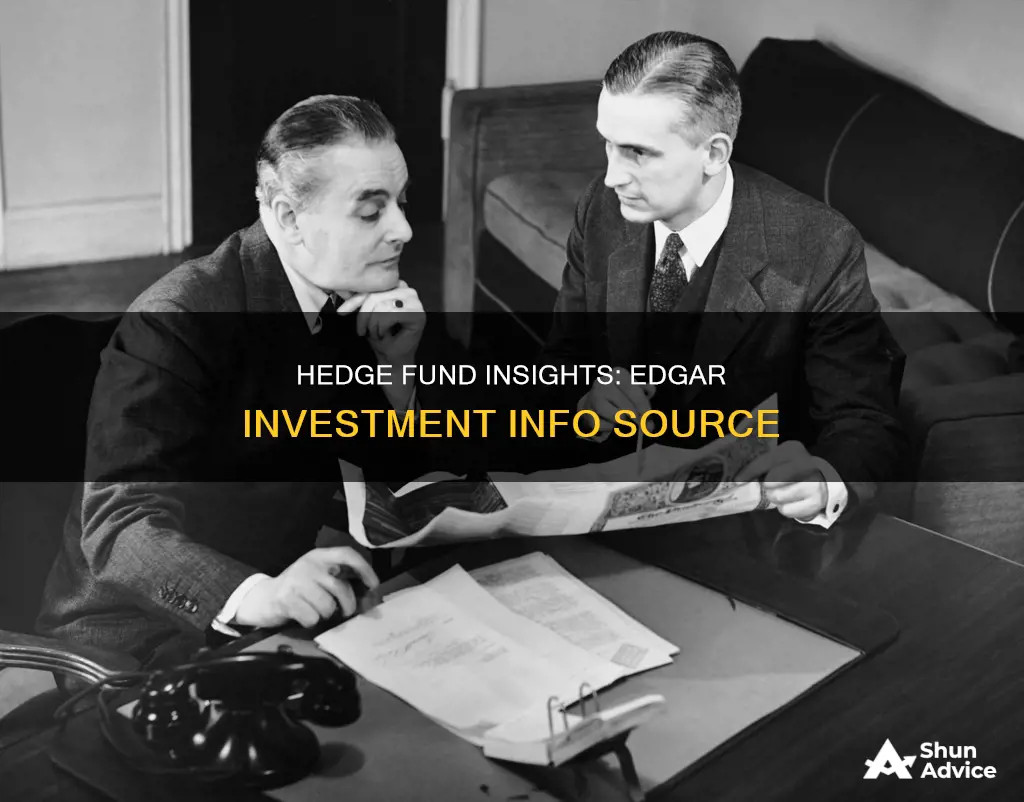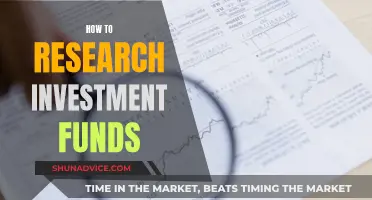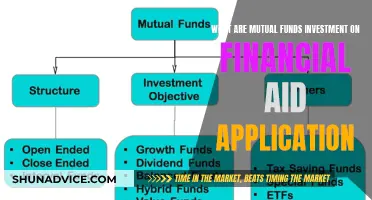
The U.S. Securities and Exchange Commission's EDGAR database provides free access to corporate information, allowing users to research a public company's financial information and operations. This includes information on hedge funds. To search for a mutual fund, ETF, or variable annuity, click on Company Filings on the SEC.gov home page to get to the EDGAR search page, where you can find tools to search for Mutual Funds and Variable Annuities. You can also use the Mutual Funds tool to search for ETFs.
| Characteristics | Values |
|---|---|
| Website | EDGAR (Electronic Data Gathering, Analysis, and Retrieval) |
| Website URL | SEC.gov |
| Owner | U.S. Securities and Exchange Commission |
| Access | Free public access to corporate information |
| Search Functionality | Yes |
| Search Parameters | Name or ticker symbol of a company, CIK lookup info, confidential treatment orders, SEC correspondence with issuers, date, company, person, filing category, location, keywords, and phrases |
| Data Availability | More than 20 years of EDGAR filings |
| Data Format | PDF, paper format |
What You'll Learn

Public companies' annual and quarterly reports
The annual report, filed on Form 10-K, provides audited financial statements, a discussion of material risk factors, and management's analysis of the company's results for the fiscal year. It is a comprehensive document that offers insights into the company's past performance and future plans. On the other hand, quarterly reports, typically filed on Form 10-Q, offer unaudited financial statements and updates on material risks, providing a more frequent snapshot of the company's financial health.
EDGAR's search functionality allows users to find these reports by entering the company's name or ticker symbol. Additionally, the full-text search feature enables keyword searches across over 20 years of filings, making it convenient to find specific information within these reports.
For investors, these annual and quarterly reports are invaluable tools for making informed investment decisions. They provide a detailed view of the company's financial position, risks, and operational results, empowering investors to assess the stability and growth potential of the business.
It is worth noting that while EDGAR provides access to a vast array of corporate information, some companies may also have their own investor relations webpages where the latest annual and quarterly reports can be found.
Vanguard Funds: Best UK Investment Options
You may want to see also

Mutual funds and ETFs
The EDGAR database provides free public access to corporate information, allowing users to research a public company's financial information and operations by reviewing the filings the company makes with the SEC. This includes information provided by mutual funds and exchange-traded funds (ETFs).
To search for a mutual fund or ETF on the SEC.gov home page, click on "Company Filings" under the search bar at the top of the page to get to the EDGAR search page. On the left side, you'll find tools optimized for searching for Mutual Funds and Variable Annuities. The Mutual Funds tool can also be used to search for ETFs.
- Registration statement (including a prospectus): The prospectus includes information about the fund, such as investment objectives, a fee table, investment strategies, risks and performance, advisers and portfolio managers, purchase and sale of fund shares, and tax information.
- Summary prospectus: A summary disclosure document that includes the same key information required at the beginning of the full prospectus.
- Periodic update to fund prospectus: Includes periodic updates to the prospectus.
- Annual/semi-annual shareholder reports: Describes how the fund has operated, including the fund's holdings and financial statements. The annual report also discusses market conditions and investment strategies that significantly affected the fund's performance during its last fiscal year.
- Definitive proxy statement: Proxy statement sent in connection with matters to be voted on by fund shareholders at the fund's shareholder meeting.
- Proxy voting record: Identifies specific proposals that the fund was entitled to vote on for its underlying portfolio holdings and how the fund voted on each.
- Schedule of portfolio holdings in exhibit to N-PORT: Includes a list of the fund's portfolio holdings for the first and third fiscal quarters, not reported on Form N-CSR.
- Registration statement for fund mergers: Disclosure document that includes information about a fund merger or other similar transaction.
In addition to finding these filings on EDGAR, they can typically also be obtained from the fund's website or through a financial professional.
U.S. Investment Fund Transition to Schwab: What, When, Why?
You may want to see also

Insider transactions
Corporate insiders, including officers, directors, and holders of more than 10% of a company's registered equity securities, are required to regularly disclose their holdings and transactions. This is done through the following statements:
- Initial statement of beneficial ownership: This is an initial statement disclosing holdings in the company's equity securities.
- Statement of changes in beneficial ownership: Transactions in the company's equity securities must be disclosed within two business days of the transaction.
- Annual statement of beneficial ownership: An annual statement disclosing holdings in the company's equity securities.
In addition, any person or group that acquires over 5% of a class of a public company's registered voting securities must disclose their holdings. This is done through Schedule 13D and Schedule 13G beneficial ownership reports. Definitive proxy statements are also used to disclose the amount of equity securities owned by directors, officers, and any person or group with over 5% ownership of the company's voting securities.
To find insider transaction information on EDGAR, you can use the search bar on the SEC.gov homepage to search for a specific company by name or ticker symbol. You can also use the EDGAR CIK (Central Index Key) Lookup to find a company's unique identifier and narrow your search. Additionally, the EDGAR Full Text Search allows you to search through filings and attachments from the last four years.
Key Factors to Consider Before Investing in Mutual Funds
You may want to see also

Public company announcements
To search for a public company, type the company's name or ticker symbol in the search bar at the top of the home page. The search results will be presented in chronological order, with the filings identified by form types, shown in the first column. For example, the form type for the annual report on Form 10-K filed by domestic public companies is "10-K".
Domestic public companies file annual and quarterly reports, as well as current reports when certain events occur that require prompt disclosure. The annual and quarterly reports include financial statements for the relevant period, a discussion of material risk factors, and management's discussion and analysis of the company's results of operations.
Public companies, mutual funds, and ETFs that are subject to SEC proxy rules send proxy statements to their shareholders to solicit their votes at shareholder meetings. These proxy statements can also be found on EDGAR and describe the matters to be voted on, including compensation and other information about the company's or fund's board and executive officers.
Additionally, companies regularly disclose their significant shareholders and institutional investment managers, such as managers of hedge funds. These disclosures can be found in the Schedule 13D or 13G beneficial ownership reports, the definitive proxy statement, or the institutional investment manager report.
The EDGAR database also includes tutorials and resources to help users locate filings, conduct research, and retrieve specific information. Users can also view a listing of real-time filings as they are submitted and daily filings by form type within the past week.
Gilt Funds: When to Invest for Maximum Returns
You may want to see also

Executive compensation
The U.S. Securities and Exchange Commission (SEC) requires clear, concise, and understandable disclosure about compensation paid to CEOs, CFOs, and other high-ranking executive officers of public companies. This information can be found in several types of documents that a company files with the SEC. These include:
- The company's annual proxy statement
- The company's annual report on Form 10-K
- Registration statements filed by the company to register securities for sale to the public
- The company's current report on Form 8-K
The annual proxy statement is typically the easiest place to look up information on executive pay. The annual report on Form 10-K and registration statements may simply refer you to the information in the annual proxy statement.
In the annual proxy statement, a company must disclose the amount and type of compensation paid to its chief executive officer, chief financial officer, and the three other most highly compensated executive officers. They must also disclose the criteria used to reach these compensation decisions and the relationship between the company's executive compensation practices and corporate performance.
The Summary Compensation Table is the cornerstone of the SEC's required disclosure on executive compensation. It provides a comprehensive overview of a company's executive pay practices in a single location. It includes the total compensation paid to the company's chief executive officer, chief financial officer, and three other most highly compensated executive officers for the past three fiscal years.
Following the Summary Compensation Table are other tables and disclosures containing more specific information on the components of compensation for the last completed fiscal year. This includes information about grants of stock options, stock appreciation rights, long-term incentive plan awards, pension plans, and employment contracts.
In addition, the Compensation Discussion and Analysis (CD&A) section explains all material elements of the company's executive compensation programs.
It is important to note that the decision regarding the amount and type of compensation given to an executive officer is a business decision and is not within the jurisdiction of the SEC. The SEC's jurisdiction extends to disclosure, ensuring that the investing public has full and fair access to material information to make informed investment and voting decisions.
Key Considerations for Investing in Algorithmic Trading Funds
You may want to see also
Frequently asked questions
EDGAR provides free public access to corporate information, allowing you to research a public company's financial information and operations. To find information on hedge funds, you can use the Mutual Funds tool to search for information provided by mutual funds, which include hedge funds.
You can access EDGAR from the SEC.gov home page.
Type the company's name or ticker symbol in the search bar at the top of the home page.
Click on Company Filings under the search bar at the top of the home page to get to the EDGAR search page. On the left side, you will find tools optimized to search for Mutual Funds and Variable Annuities.
A public company's annual report includes audited annual financial statements, a discussion of material risk factors for the company and its business, and a management's discussion and analysis of the company's results of operations for the prior fiscal year.







